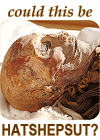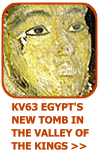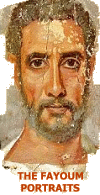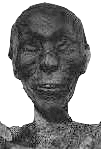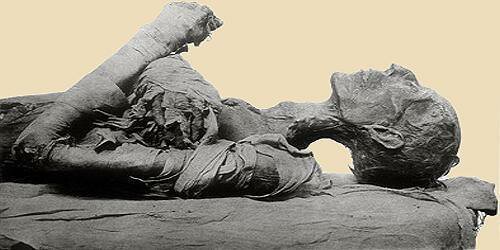|
|
|||||||||||||||||||||||||||||||||||||||||||||||
|
|
Pharaoh profiles: Akhenaten | Alexander the Great | Cleopatra VII | Hatshepsut | Ramesses the Great | Tutankhamun | Tuthmosis III The remarkably lifelike mummies from the Royal Cache The Royal Cache is the name given to a secret rock cut tomb in the limestone ridge by Deir el-Bahri near the Valley of the Kings. In this tomb were discovered several royal mummies which had been hidden by priests of the 21st Dynasty in an attempt to prevent any further desecration and robbery of the royal tombs. The first group were discovered by the three Rassul brothers in the 1870's. They plundered the tomb in secret until Egyptologists working undercover were led there in 1881. The first cache consisted of an amazing 40 mummies, belonging to many famous pharaohs. A second cache was discovered in the tomb of Amenhotep II in the Valley of the Kings in 1898.
The story behind the Royal Cache During the 21st Dynasty, priests and officials in Thebes undertook a comprehensive restoration programme of the royal mummies which had been desecrated during the preceding years of strife and disorder. This "pious" act involved the removal of the mummies from their tombs in the Valley of the Kings to either the mortuary temple of Rameses III at Medinet Habu, or the empty tomb of Rameses XI in the valley itself. In these two "workshops", all the valuable materials, including gold leaf and semi precious inlays, were stripped off of the coffins for recycling.
Mummies which had been violated by ancient tomb robbers were repaired and rewrapped, before being stored in temporary hiding places en route to their secret rendezvous at the Royal Cache. Dockets on the coffins told part of the story of these complex manoeuvres. The writings on the mummy cases of Ramesses I, Seti I and Ramesses II were of particular interest.
What the dockets said on the coffin of Ramesses II The ancient scribe began his text on the chest of the lid of Ramesses II's coffin:
He then listed the names and titles of the officials involved in the operation:
Ankhefenamun and his four colleagues removed the body of Ramesses II from the tomb of his father Seti and took it up to another tomb known as the High Track of Inhapi. Other almost identical dockets were painted on the coffins of both Ramesses I and Seti I, except that their cartouches were substituted for those of Ramesses II. Mummies found in the 1881 Royal Cache included:
Mummies found in the 1898 Royal Cache (tomb of Amenhotep II) included:
|
||||||||||||||||||||||||||||||||||||||||||||||

|
|||||||||||||||||||||||||||||||||||||||||||||||
|
|||||||||||||||||||||||||||||||||||||||||||||||




